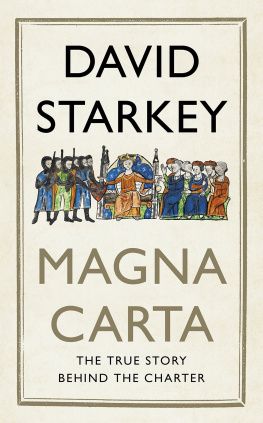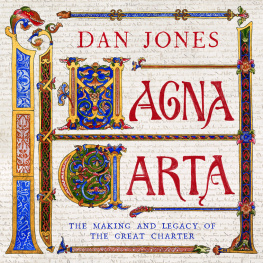In the Shadow of the
Great Charter
In the Shadow of the
Great Charter
Common Law Constitutionalism
and the Magna Carta
Robert M. Pallitto
University Press of Kansas
2015 by the University Press of Kansas
All rights reserved
Published by the University Press of Kansas (Lawrence, Kansas 66045), which was organized by the Kansas Board of Regents and is operated and funded by Emporia State University, Fort Hays State University, Kansas State University, Pittsburg State University, the University of Kansas, and Wichita State University
Library of Congress Cataloging-in-Publication Data
Pallitto, Robert M., 1964 author.
In the shadow of the great charter : common law constitutionalism and the
Magna Carta / Robert M. Pallitto.
pagescm
Includes bibliographical references and index.
ISBN 978-0-7006-2091-3 (cloth : alk. paper) ISBN 978-0-7006-2092-0 (ebook)
1. Civil rightsUnited StatesHistory. 2. Constitutional historyUnited States.
3. Magna Carta. 4. LawUnited States. English influences. I. Title.
KF4749.P35 2015
342.73024dc23
2014045940
British Library Cataloguing-in-Publication Data is available.
Printed in the United States of America
10987654321
The paper used in this publication is recycled and contains 30 percent postconsumer waste. It is acid free and meets the minimum requirements of the American National Standard for Permanence of Paper for Printed Library Materials Z39.48-1992.
For my parents,
Kathryn Motoviloff and Robert E. Pallitto
Contents
Acknowledgments
It has been tremendously enjoyable and gratifying to explore the Magna Cartas legacy in the United States, and the help and support given me by others have made the experience an especially good and valuable one. Charles Myers first encouraged me to pursue this project, and since then he has guided me through it expertly at every step. I owe him a great debt of thanks, and it has truly been a pleasure to work with him. Eric Kasper and the anonymous reviewers of the manuscript made many astute and constructive suggestions for improving it, and I am most grateful for their advice and feedback as well. Any errors, of course, are my own responsibility. This book had its genesis in a symposium-in-print on the meaning and legacy of the Magna Carta, which was edited by Kenton Worcester in 2010 for the journal PS: Political Science and Politics.
Many friends, family members, and colleagues provided support of one kind or another. In particular, I would like to thank (in no particular order) Ana Melendez, Larry Perfetti, Emily Bregman, Bob and Gwyn Murray, Ellen, Roger, and Andrew Miller, John and Kerry Motoviloff, Christina Pallitto, Ben Smith, Kathryn Motoviloff, Robert E. Pallitto, Jeff Hasler, Cheryl Hulteen, David Plotke, Patricia J. Williams, and Louis Fisher. My friends and colleagues in Seton Halls Department of Political Science and Public Affairs were always positive, supportive, and encouraging as I saw this project to completion. Special thanks to Wigeby Toussaint for encouragement and countless acts of helpfulness. I am extremely fortunate to work with such an exceptional group of people, and I hope they know how much I appreciate them.
This book was written during my sabbatical in 2013. I am most grateful to Seton Hall University for allowing me a break from normal teaching and service responsibilities so that I could immerse myself in English and American legal history. As any scholar knows, there is nothing more valuable than uninterrupted time to write.
My children, John, Daniel, and Isabel, bring me more happiness than I can describe here, and I thank them for simply being themselves. Finally, I want to thank Laura Melendez for being there to see me through another book, giving me confidence when I lacked it and love when I needed it. Her companionship is a constant joy.
1
Introduction
Magna Carta has been preserved not as a museum piece, but as part of the common law of England, to be defended, maintained or repealed as the needs and function of the law required. That so much of what survives is now concerned with individual liberty is a reflexion of the quality of the original act of 1215. It was adaptable. This was its greatest and most important characteristic.
J. C. H OLT , Magna Carta
In a world drastically changed by the 9/11 attacks, Supreme Court justice Anthony Kennedy authored a 2008 legal opinion deciding whether war on terror detainees could be barred from U.S. courts. By military order and congressional act, the U.S. government had declared that these detainees, many of whom were confined at the Guantanamo Bay Naval Base, were not entitled to petition the federal courts for release from their confinement. Once they were determined to be properly classified as enemy combatants, they would be tried before a military tribunal or simply detained indefinitely. The doors of the federal courts were closed to them.
The detainees claimed that stripping the courts of jurisdiction in this way was unlawful. They sought to file habeas corpus petitions in federal court, following a time-honored procedure in Anglo-American law by which prisoners challenge the governments authority to hold them. In the United States, habeas corpus is enshrined in constitutional text. The constitution requires that the writ of habeas corpus be available to prisoners at all times unless Congress explicitly suspends it and effectively declares martial law. Because there had been no formal suspension, the detainees reasoned, they were entitled to make habeas corpus petitions and could not be blocked from doing so.
Justice Kennedy agreed and ruled in the detainees favor. His majority opinion linked the writ of habeas corpus to the U.S. Constitution, of course, but also to a much earlier document: the Magna Carta, or Great Charter, of AD 1215. For Kennedy, habeas corpus became the means by which the promise of Magna Carta was fulfilled. Among its numerous provisions setting forth rules for interactions between King John and the English nobility of the time, the Magna Carta declared in Article 39 that no one would be imprisoned except by the law of the land. It was this provision that Kennedy took to contain the promise of liberty, a promise that had been redeemed in modernity by the emergence of habeas corpus as an accepted and regularly used form of pleading. He ascribed more than a symbolic significance to the 800-year-old document; he acknowledged its immediate practical effect on legal outcomes. The Constitution requires scrupulous protection of habeas corpus rights, and Kennedy traced that requirement back to the Magna Carta.
Why would the Supreme Court continue, today, to invoke an agreement between an English king and his barons that was made eight centuries agoand to cite it as a source of individual rights and a limitation on government power? Why, especially, would it do so in the midst of a national security crisis brought on by the 2001 terror attacks? To address these specific questions is to probe the history of modern civil liberties, but it is also to explore the process by which judges go about deciding individual rights cases. First, though, some historical background on the Magna Carta itself is in order.
The Magna Cartas Origins
The Magna Carta was signed at Runnymede in June 1215. King John met an armed group of barons dressed for war in a meadow on the river Thames. The king gave his seal to the document, and it was signed by a group of barons who represented the rebellious faction. The signing/sealing of the Magna Carta concluded tense and protracted negotiations precipitated by complaints and disputes between the king and the barons regarding the kings use of power. In the course of the dispute, the rebel barons had taken control of London, and they were actually in possession of the city as they negotiated with the Crown. There is much historical evidence to establish a high level of tension and an imminent threat of violence in 1215 England. In addition to the physical occupation of London by the barons, there were letters of safe conduct issued to certain members of the nobility by King John in the weeks leading up to the June 19 ceremony at Runnymede. The king issued these letters so that the nobles could travel freely through the realm without fear of arrest or attack. The need for such documentation suggests a state of hostility between the warring groups. The barons sought guarantees of reform from the king in exchange for a promise that they would remain loyal to him. A copy of this document was retained by Stephen Langton, the archbishop of Canterbury, who served as intermediary between the disputants, and it formed an agreement in principle indicating that progress in negotiations had taken place. The parties then made a firm peace at Runnymede on June 19, as the Articles of the Barons became the Magna Carta, and both sides agreed to be bound by its terms. Although a firm peace was reached on June 19 as the barons reestablished their loyalty to the king, the pacifying effect of the Charter did not last long. Two months later (after the immediate danger of war had passed), Pope Innocent III annulled it, claiming that the king had only agreed to its terms under duress. Following annulment, hostilities resumed. The Magna Carta was reinstated and reissued several times subsequently, most immediately in 1216, 1217, and 1225. The 1215 text is set forth in the appendix.













